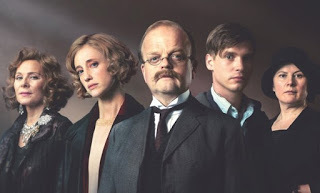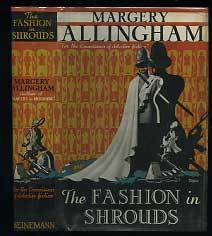Martin Edwards's Blog, page 150
December 26, 2016
The Witness for the Prosecution - BBC TV review
 The Witness for the Prosecution, part one of which aired on the BBC tonight, was always going to be one of the main events on this year's Christmas TV schedule. Agatha Christie's short story (originally written very early in her career, more than 90 years ago) was later turned into a play. In 1957, it was famously filmed by Billy Wilder.
The Witness for the Prosecution, part one of which aired on the BBC tonight, was always going to be one of the main events on this year's Christmas TV schedule. Agatha Christie's short story (originally written very early in her career, more than 90 years ago) was later turned into a play. In 1957, it was famously filmed by Billy Wilder.Wilder's version boasted a crisp script and a terrific cast, including Marlene Dietrich, Tyrone Power, and Charles Laughton. It is my favourite movie based on a Christie story. and set a very high standard for any subsequent adaptation. The BBC commissioned Sarah Phelps to write the new screenplay, a sound decision bearing in mind her good work last year with the script for And Then There Were None.
Less obvious was the decision to turn the story into a two hour-long episodes. That choice meant that Phelps was required to add quite a lot of backstory material - rather more than was needed last year. To update a Christie to this extent is always a risky enterprise, and Phelps' solution to the challenge is, in part, to focus on period atmosphere. In the first episode, this worked fairly well, but (pending seeing episode two) I'm inclined to think that a single 90-minute drama might have had more focus, and therefore greater intensity. There's a lot of darkness in this version, but that's not quite the same as intensity.
The BBC cast, if not quite in the league of Dietrich and company, is pretty good, with Toby Jones impressive as usual, playing the part of a down-at-heel solicitor. Naturally I empathised with him, jsut as Harry Devlin would. Billy Howie takes the role of Leonard Vole, while Andrea Riseborough is Romaine, and Kim Cattrall the older woman who takes up with a toy boy before meeting an untimely end. This version of a classic crime story has not yet displaced Wilder's film in my affections, and probably won't do so, but I will certainly be watching to see how Phelps handles the rest of the story.
Published on December 26, 2016 15:46
Maigret's Dead Man - ITV and book review

Maigret's Dead Man was ITV's big Christmas Day production, marking a return to the screen for Rowan Atkinson as Jules Maigret. The screenplay by Stewart Harcourt was based on Georges Simenon's novel, a new edition of which I've just received for review from Penguin, who are steadily bringing back all the Maigret novels into print. (A big project - there are more than seventy of them...)
Atkinson's first outing as Maigret,
A number of very violent robberies and murders are taking place at farms in Picardie. Maigret's assistance is sought, but he is distracted by the mysterious beating and murder of a man who has been trying to contact him by phone. The dead man said that Maigret knew his wife Nina, but the name rings no bells with the detective. We see some of the events of the dead man's last day - he is being pursued by two toughs, but we don't know why. Maigret is told not to waste his time on a gangland killing, but of course he is too persistent to let the matter slide.
When I first read Simenon as a teenager, I was disappointed that the Maigret stories weren't classic twisty whodunits. Nowadays I appreciate their virtues - in particular their glances at character, and their humanity. At the end of the TV programme, the adoption of a young child is proposed, and I was curious to see whether this was something just tacked on for the benefit of telly audiences (I wasn't sure the adoption was such a great idea, I must admit; to say why would be a spoiler). It turns out that that this strand of the finale is replicated, more or less, in the novel. Interesting. Overall, a good programme (although 90 minutes would have been a better length than 2 hours), and a good book.
Published on December 26, 2016 02:53
December 23, 2016
Forgotten Book - Another Little Christmas Murder
I thought that for today's Forgotten Book I'd adopt a seasonal approach. A Christmas crime story, and one that is easy to buy as a present, or for yourself. (I'm assuming, of course, that you're already stocked up with The Golden Age of Murder, Crimson Snow, Silent Nights, and the other Brtish Library Crime Classics,and...well, you get the picture!) So I was rather pleased to receive a new paperback with an appropriately snow-covered cover from Sphere -also the excellent publishers, I should say, of Motives for Murder, another book you really ought to treat yourself to!
The book in question is called Another Little Christmas Murder, and the author is Lorna NIcholl Morgan. She is, like Francis Duncan, author of a republished vintage Yuletide mystery that came out a year ago, someone whose work has long been forgotten. There's a difference between Morgan and Duncan on the one hand, and J.Jefferson Farjeon, author of Mystery in White, on the other: Farjeon was highly regarded in his day, whereas Duncan and Morgan never made much impression even when they were publishing new books.
In Morgan's case, that's partly because she only published four books - in a concentrated burst between 1944 and 1947. This was the last of them to appear - under the title Another Little Murder. There's no information about Morgan's life or other books in this edition, and I do think that's a pity. I'm sure I'm not alone in feeling like that: countless people have contacted me from all around the world saying they've loved learning more about the likes of John Bude and company in the BL Crime Classics.
The massive success of Mystery in White created a bandwagon effect, and this year there are lots of books in the shops with Christmassy titles and cover artwork ,quite apart from the BL titles. Yet despite the change to the title of this book, the story does not actually take place at Christmas, which hasn't even arrived by the time the story comes to an end! This was a disappointment.
So what of the story itself? Well, I liked Dilys, the feisty young commercial traveller whose car gets stuck in the snow in a remote bit of Yorkshire, and who is offered refuge in a country house where there are plenty of mysterious goings-on. The book starts well, but the plot is weak, and my enthusiasm began to fade after fifty pages or so. In particular the criminal conspiracy at the heart of the plot is one that the author seems not to have really believed in herself, and I certainly didn't. I'm afraid I may be able to guess why this was her last published book. But never mind, this is the season of goodwill, and I want to end on a positive note. Morgan could write well, and she had a good sense of humour. I particularly liked the character who is an odious health fanatic. And Dilys is so engaging that it's a shame that she never had any more recorded adventures.
The book in question is called Another Little Christmas Murder, and the author is Lorna NIcholl Morgan. She is, like Francis Duncan, author of a republished vintage Yuletide mystery that came out a year ago, someone whose work has long been forgotten. There's a difference between Morgan and Duncan on the one hand, and J.Jefferson Farjeon, author of Mystery in White, on the other: Farjeon was highly regarded in his day, whereas Duncan and Morgan never made much impression even when they were publishing new books.
In Morgan's case, that's partly because she only published four books - in a concentrated burst between 1944 and 1947. This was the last of them to appear - under the title Another Little Murder. There's no information about Morgan's life or other books in this edition, and I do think that's a pity. I'm sure I'm not alone in feeling like that: countless people have contacted me from all around the world saying they've loved learning more about the likes of John Bude and company in the BL Crime Classics.
The massive success of Mystery in White created a bandwagon effect, and this year there are lots of books in the shops with Christmassy titles and cover artwork ,quite apart from the BL titles. Yet despite the change to the title of this book, the story does not actually take place at Christmas, which hasn't even arrived by the time the story comes to an end! This was a disappointment.
So what of the story itself? Well, I liked Dilys, the feisty young commercial traveller whose car gets stuck in the snow in a remote bit of Yorkshire, and who is offered refuge in a country house where there are plenty of mysterious goings-on. The book starts well, but the plot is weak, and my enthusiasm began to fade after fifty pages or so. In particular the criminal conspiracy at the heart of the plot is one that the author seems not to have really believed in herself, and I certainly didn't. I'm afraid I may be able to guess why this was her last published book. But never mind, this is the season of goodwill, and I want to end on a positive note. Morgan could write well, and she had a good sense of humour. I particularly liked the character who is an odious health fanatic. And Dilys is so engaging that it's a shame that she never had any more recorded adventures.
Published on December 23, 2016 06:10
December 22, 2016
Another Death in Paradise?
 Of the nine islands that I visited on my recent Caribbean trip, French was the principal language on just one, Guadeloupe (and one of two principal languages on St Maarten, an island split between the French and the Dutch). I found Guadeloupe fascinating, and not only because it's the place where that highly successful TV series Death in Paradise is filmed. The creator of the series, Robert Thorogood, named his fictional main town Honore, a hat tip to the scene of the crime in Agatha Christie's A Caribbean Mystery.
Of the nine islands that I visited on my recent Caribbean trip, French was the principal language on just one, Guadeloupe (and one of two principal languages on St Maarten, an island split between the French and the Dutch). I found Guadeloupe fascinating, and not only because it's the place where that highly successful TV series Death in Paradise is filmed. The creator of the series, Robert Thorogood, named his fictional main town Honore, a hat tip to the scene of the crime in Agatha Christie's A Caribbean Mystery.


I didn't actually make it to the resort where the show is filmed, though one couple did make that specific pilgrimage, such is their love of the series. But Guadeloupe is full of interesting and often very beautiful places. And my interest in the macabre was piqued by the fascinating "checkerboard cemetery" to which we were taken. I've never seen anything quite like it.

During my trip, I managed to do plenty of reading, and the books I devoured will feature on this blog in the near future. I also had time to think about my current work in progress. But even more importantly in the long run, perhaps, I was able to continue my research into Caribbean life. I'm hoping to make something substantial out of this.
 My fascination with the area has already resulted in two short stories. "A Glimpse of Hell", set in Gran Cayman, has already been published, while "Farewell Cruise" should appear in print next year. But I also have other plans in mind, which will draw on the research I've managed to undertake during my various trips to the area over the past three years. It will be a while before I'm in a position to talk further about these plans, but suffice to say that I am sure that Death in Paradise has not exhausted the possibilities for Caribbean-based crime fiction, and what I have in mind is something very different.
My fascination with the area has already resulted in two short stories. "A Glimpse of Hell", set in Gran Cayman, has already been published, while "Farewell Cruise" should appear in print next year. But I also have other plans in mind, which will draw on the research I've managed to undertake during my various trips to the area over the past three years. It will be a while before I'm in a position to talk further about these plans, but suffice to say that I am sure that Death in Paradise has not exhausted the possibilities for Caribbean-based crime fiction, and what I have in mind is something very different.
Published on December 22, 2016 02:36
December 20, 2016
Another Caribbean Mystery Tour
I've just returned from a wonderful trip, exploring the Caribbean (for reasons which I'll talk about a little tomorrow). Drinking rum punch at 90 degrees Fahrenheit in lovely St Thomas in the US Virgin Islands, as I was last Friday, is - I need hardly say - a great way to run up to Christmas. Even if it does mean that my Yuletide preparations so far are more or less non-existent.and the process of adapting back to chilly Cheshire is a bit of a challenge.
The trip started with a couple of days in Puerto Rico. It's an island which was for many years home to Muna Lee, one half of the writing duo Newton Gayle which produced five high calibre mysteries in the Golden Age. Murder at 28:10 is an atmospheric story set on the island during the hurricane season which I enjoyed some time ago, but of course there's no substitute for seeing the real place. I was very taken with Puerto Rico,and the historic capital San Juan.
After San Juan came a cruise, mostly to islands that I'd never visited before. There are many reasons why I enjoy cruising - prime among them is the chance to sample fresh places, and expand my knowledge and understanding of the world, and the different people who live in it. It's something that, I've had more of a chance to do in recent time than for most of my life, and for any author, that exposure to fresh cultures and fascinating people has to be hugely beneficial.
Two islands I had visited previously were Barbados and St Lucia. Holidays on Barbados inspired Agatha Christie to write A Caribbean Mystery, one of the first detective stories I ever read, although she located her crime on the fictional island of St Honore. I don't, however, know which island inspired the setting of Roger East's rather less well-known, but memorably titled Twenty-Five Sanitary Inspectors, which is set in a fictional West Indian republic. .
The trip started with a couple of days in Puerto Rico. It's an island which was for many years home to Muna Lee, one half of the writing duo Newton Gayle which produced five high calibre mysteries in the Golden Age. Murder at 28:10 is an atmospheric story set on the island during the hurricane season which I enjoyed some time ago, but of course there's no substitute for seeing the real place. I was very taken with Puerto Rico,and the historic capital San Juan.
After San Juan came a cruise, mostly to islands that I'd never visited before. There are many reasons why I enjoy cruising - prime among them is the chance to sample fresh places, and expand my knowledge and understanding of the world, and the different people who live in it. It's something that, I've had more of a chance to do in recent time than for most of my life, and for any author, that exposure to fresh cultures and fascinating people has to be hugely beneficial.
Two islands I had visited previously were Barbados and St Lucia. Holidays on Barbados inspired Agatha Christie to write A Caribbean Mystery, one of the first detective stories I ever read, although she located her crime on the fictional island of St Honore. I don't, however, know which island inspired the setting of Roger East's rather less well-known, but memorably titled Twenty-Five Sanitary Inspectors, which is set in a fictional West Indian republic. .
Published on December 20, 2016 12:10
December 19, 2016
Rogue's Yarn - 1957 film review
Rogue's Yarn is a film released in 1957 which has recently featured on the Talking Pictures TV channel. The clever screenplay, by Vernon Sewell and Ernie Bradford, is an "inverted mystery", and the story is told in gripping fashion. It may not be Dial M for Murder, but it's not far short of Hitchcock's much better known movie in terms of storytelling quality. A well-made film, it's definitely worth watching.
Our attention is grabbed right at the start. Michele Cartier (Nicole Mauray) is waiting for the arrival of her lover, John Marsden (Derek Bond, the best-known actor in the cast). He announces that he has bad news. This turns out to be an announcement that his invalid wife, whose death the pair had been eagerly anticipating, is now expected to make a full recovery from serious illness.
The snag is that the wife is very rich, and the lovers are desperate not only to get together, but to do so with Mrs Marsden's money. The only solution is murder. Marsden, an accomplished sailor, quickly works out an elaborate plan which involves taking his boat on a trip to Le Havre to create an alibi, then swimming back to the English shore to do the dirty deed.
At first, all goes well. Unfortunately, the Yard are called in, and Inspector Walker (Elwyn Brook-Jones, who is very good in the role) decides to take a closer look at the circumstances of the crime. We know that all is not likely to go well for Marsden, and we don't like him enough to root for him to get away with it, but there are several memorable moments, notably including a great scene where Walker, not once but several times, nearly walks into a fatal trap set by the bad guy.
Our attention is grabbed right at the start. Michele Cartier (Nicole Mauray) is waiting for the arrival of her lover, John Marsden (Derek Bond, the best-known actor in the cast). He announces that he has bad news. This turns out to be an announcement that his invalid wife, whose death the pair had been eagerly anticipating, is now expected to make a full recovery from serious illness.
The snag is that the wife is very rich, and the lovers are desperate not only to get together, but to do so with Mrs Marsden's money. The only solution is murder. Marsden, an accomplished sailor, quickly works out an elaborate plan which involves taking his boat on a trip to Le Havre to create an alibi, then swimming back to the English shore to do the dirty deed.
At first, all goes well. Unfortunately, the Yard are called in, and Inspector Walker (Elwyn Brook-Jones, who is very good in the role) decides to take a closer look at the circumstances of the crime. We know that all is not likely to go well for Marsden, and we don't like him enough to root for him to get away with it, but there are several memorable moments, notably including a great scene where Walker, not once but several times, nearly walks into a fatal trap set by the bad guy.
Published on December 19, 2016 12:09
December 16, 2016
Forgotten Book - Death of a Queen
Death of a Queen by Christopher St John Sprigg is definitely a Forgotten Book. I've been searching for it in vain for many years, but I finally had an opportunity to read the British Library's copy. If you found a nice copy in a dust jacket, it would be a good investment, I suspect, because the BL's republication of Sprigg's Death of an Airman has led to a renewal of interest in this fascinating author. Some people have told me that book is their favourite in the Crime Classics series.
Published in 1935, this was the last conventional whodunit to appear under Sprigg's name prior to his untimely death in the Spanish Civil War. (Six Queer Things was published posthumously). The book is sub-titled "Charles Venables' fourth case", and here the journalist is called upon by Whitehall to assist a sympathetic (and conveniently English-speaking) tiny state in the Balkans.
My heart sank when I realised that this story takes place in Iconia. So many Golden Age books have plots or sub-plots involving sub-Ruritanian kingdoms on the brink of revolution, and handle the material ineptly. But Sprigg recognises the difficulties, and explicitly, if rather cheekily, makes it clear at the outset that Iconia is no Ruritania. He also invents the country's history, heritage and architecture with great enthusiasm, and this makes the story all the more appealing.
What's more, there is a very good "impossible crime" at the heart of the story. How did the eponymous monarch - strangled with a silken cord - meet her end, when her chamber was under constant observation, and nobody saw the murderer go in or out? Sprigg handles the unlikely plot twists with gusto. All in all, this is an enjoyable story, extremely far-fetched, but told with youthful zest. I'm glad I overcame my initial reservations and read it through to the end.
Published in 1935, this was the last conventional whodunit to appear under Sprigg's name prior to his untimely death in the Spanish Civil War. (Six Queer Things was published posthumously). The book is sub-titled "Charles Venables' fourth case", and here the journalist is called upon by Whitehall to assist a sympathetic (and conveniently English-speaking) tiny state in the Balkans.
My heart sank when I realised that this story takes place in Iconia. So many Golden Age books have plots or sub-plots involving sub-Ruritanian kingdoms on the brink of revolution, and handle the material ineptly. But Sprigg recognises the difficulties, and explicitly, if rather cheekily, makes it clear at the outset that Iconia is no Ruritania. He also invents the country's history, heritage and architecture with great enthusiasm, and this makes the story all the more appealing.
What's more, there is a very good "impossible crime" at the heart of the story. How did the eponymous monarch - strangled with a silken cord - meet her end, when her chamber was under constant observation, and nobody saw the murderer go in or out? Sprigg handles the unlikely plot twists with gusto. All in all, this is an enjoyable story, extremely far-fetched, but told with youthful zest. I'm glad I overcame my initial reservations and read it through to the end.
Published on December 16, 2016 04:08
December 14, 2016
Endless Night - 1972 film review
Endless Night is one of the very best books that Agatha Christie wrote in the last fifteen years of her life. I think it's under-rated, perhaps because it re-uses one of her earlier ideas for a plot twist. But it does so in a very pleasing way. Not an easy book to adapt for the big screen, though, and the 1972 film version is not, I think, widely admired.
But when I saw it as a student, I enjoyed it, and when I watched it again the other night, I enjoyed it all over again. This was the last film directed by Sidney Gilliat, a talented director whose previous work included the film of Green for Danger, and a writing credit for The Lady Vanishes. He does a fairly good job of handling the plot twists, though of necessity he has to make various changes to the story structure. One or two scenes are a little clumsy, but overall I think it works.
Gilliat had the benefit of an excellent cast. Hywel Bennett, who plays Mike Rogers, a drifter who marries a rich woman, is excellent. At around this time, Bennett was a bankable actor. He was charismatic, and very good at playing ambivalent characters. He'd have been superb as one of Ruth Rendell's amiable sociopaths - what a shame this never happened. And he was very good as the homicidal doctor in the 70s TV version of Malice Aforethought.
Two contrastingly beautiful women, Hayley Mills and Britt Ekland, play crucial roles in the story, while George Sanders is suitably suave as the family lawyer, and Peter Bowles plays the likeable cad with his customary gusto. This is an eerie mystery, about an apparent curse, a magnificent house, and a diabolical murder scheme, and it all makes for good entertainment.
But when I saw it as a student, I enjoyed it, and when I watched it again the other night, I enjoyed it all over again. This was the last film directed by Sidney Gilliat, a talented director whose previous work included the film of Green for Danger, and a writing credit for The Lady Vanishes. He does a fairly good job of handling the plot twists, though of necessity he has to make various changes to the story structure. One or two scenes are a little clumsy, but overall I think it works.
Gilliat had the benefit of an excellent cast. Hywel Bennett, who plays Mike Rogers, a drifter who marries a rich woman, is excellent. At around this time, Bennett was a bankable actor. He was charismatic, and very good at playing ambivalent characters. He'd have been superb as one of Ruth Rendell's amiable sociopaths - what a shame this never happened. And he was very good as the homicidal doctor in the 70s TV version of Malice Aforethought.
Two contrastingly beautiful women, Hayley Mills and Britt Ekland, play crucial roles in the story, while George Sanders is suitably suave as the family lawyer, and Peter Bowles plays the likeable cad with his customary gusto. This is an eerie mystery, about an apparent curse, a magnificent house, and a diabolical murder scheme, and it all makes for good entertainment.
Published on December 14, 2016 01:30
December 12, 2016
The Haunted Library and Lost in a Pyramid
The British Library publishes a wide range of books. Naturally, my focus is on the Classic Crime series, but I've also enjoyed a number of their other publications in recent times. And just in time for Christmas, they've published two short story collections which are very much in keeping with the tradition of spooky stories for a dark winter's night.
The Haunted Library (great title!) is a volume of stories selected by Tanya Kirk. She was responsible for the BL's excellent Gothic Imagination exhibition last year- which I really enjoyed. Now she's put together a book of classic ghost stories by a range of authors, several of whom I'm not familiar with. The obvious exception is M.R. James, and "The Tractate Middoth" was televised a couple of years back. A notable story, ideal for this particular book.
Other notable contributors include Edith Wharton, Algernon Blackwood and Elizabeth Bowen. But I'd never heard of A.N.L. Munsby or one or two of the others. Mixing familiar writers with those who are long neglected is a good recipe for an anthology of this kind. A similar approach has been adopted by Andrew Smith, who is responsible for Lost in a Pyramid and other classic Mummy stories..
Andrew Smith's intro talks very interestingly about his subject, and it directed me to a book by Roger Luckhurst about "mummy curse" fiction, which I've just bought. "Lot no. 249" by Arthur Conan Doyle is the only story I've read before, but a varied range of contributors, including Louisa May Alcott, Grant Allen, and Sax Rohmer ensure that there's plenty of entertainment for mummy fans everywhere!.
The Haunted Library (great title!) is a volume of stories selected by Tanya Kirk. She was responsible for the BL's excellent Gothic Imagination exhibition last year- which I really enjoyed. Now she's put together a book of classic ghost stories by a range of authors, several of whom I'm not familiar with. The obvious exception is M.R. James, and "The Tractate Middoth" was televised a couple of years back. A notable story, ideal for this particular book.
Other notable contributors include Edith Wharton, Algernon Blackwood and Elizabeth Bowen. But I'd never heard of A.N.L. Munsby or one or two of the others. Mixing familiar writers with those who are long neglected is a good recipe for an anthology of this kind. A similar approach has been adopted by Andrew Smith, who is responsible for Lost in a Pyramid and other classic Mummy stories..
Andrew Smith's intro talks very interestingly about his subject, and it directed me to a book by Roger Luckhurst about "mummy curse" fiction, which I've just bought. "Lot no. 249" by Arthur Conan Doyle is the only story I've read before, but a varied range of contributors, including Louisa May Alcott, Grant Allen, and Sax Rohmer ensure that there's plenty of entertainment for mummy fans everywhere!.
Published on December 12, 2016 01:30
December 9, 2016
Forgotten Book - The Fashion in Shrouds

The description "forgotten book" is, to be honest, a misnomer when it comes to Margery Allingham's 1938 novel The Fashion in Shrouds. The famous Observer critic Torquemada extolled the book, saying, "To Albert Campion has fallen the honour of being the first detective to figure in a story which is also by any standard a distinguished novel". I'm not sure whether Dorothy L.Sayers would have agreed; perhaps she'd have thought that she'd beaten her friend Allingham to that particular achievement. But it's undeniably a stylish novel.
Time and again there are pleasing and inventive turns of phrase, of a kind that one doesn't usually find in the typical Golden Age mystery. What's more, the presentation of the fashion world, which provides, in the early stages of the story, an interesting setting, is convincing. Allingham's presentation of character generally avoids the usual cliches, and the relationship Campion has with the lovely young Amanda Fitton is quite subtly done.
It's not easy to read this book in the precisely way that readers in 1938 would have read it. There's a good deal about social class, and the role of women in society, that relates to the time, and although Allingham handles these issues in a thoughtful way, so much has changed. Overall, I did not find these aspects of the book to be as compelling as some of her admirers suggest. For me, as with Sayers' Gaudy Night, Fashion in Shrouds does sacrifice something in the attempt at literary sophistication. The plot simply isn't as exciting as, say, the plot of Christie's The ABC Murders or Wade's Lonely Magdalen.- and the latter also offers a fascinating picture of society, and the role of police in enforcing the law.
What of the story? The amoral Georgia Wells poses a threat to the relationship between Campion's sister Valentine and Alan Dell (for whose company Amanda works).Georgia's husband is murdered, and the fate of his predecessor also comes under the microscope. But the plot is secondary, I think, and for that reason I don't feel tempted to rave about this book in the way its most ardent fans do. Even so, I enjoyed reading it, and as Torquemada said, the writing is distinguished.
, .
Published on December 09, 2016 14:32



